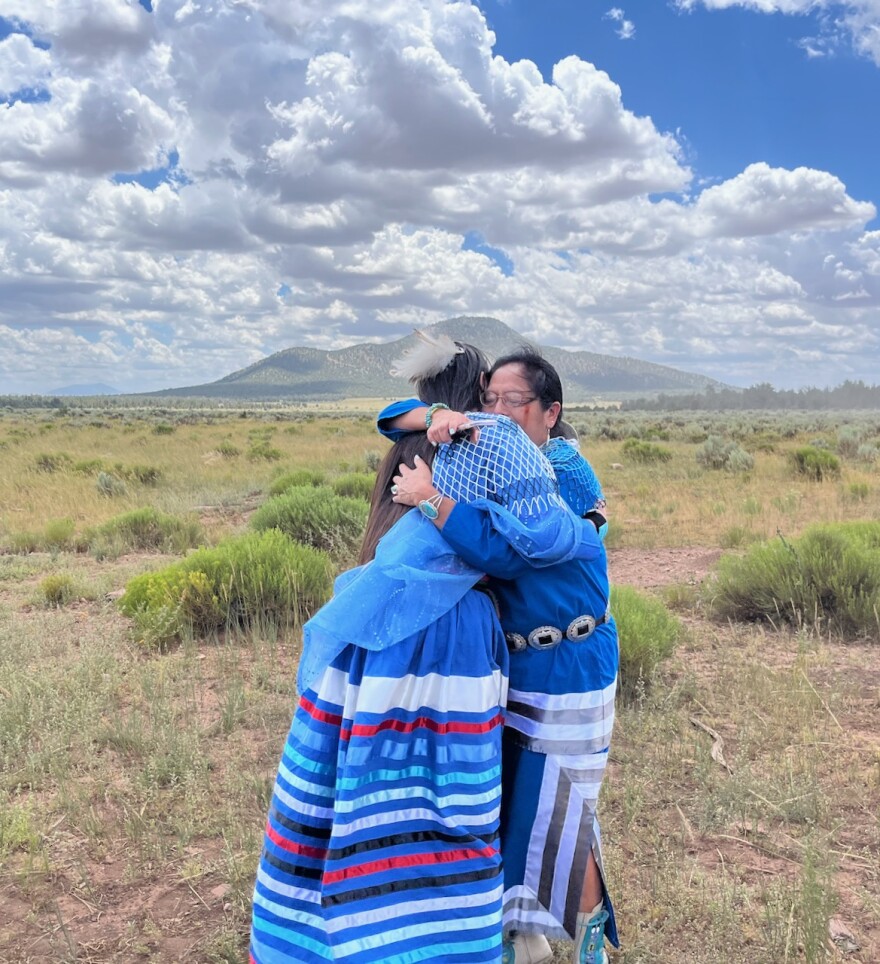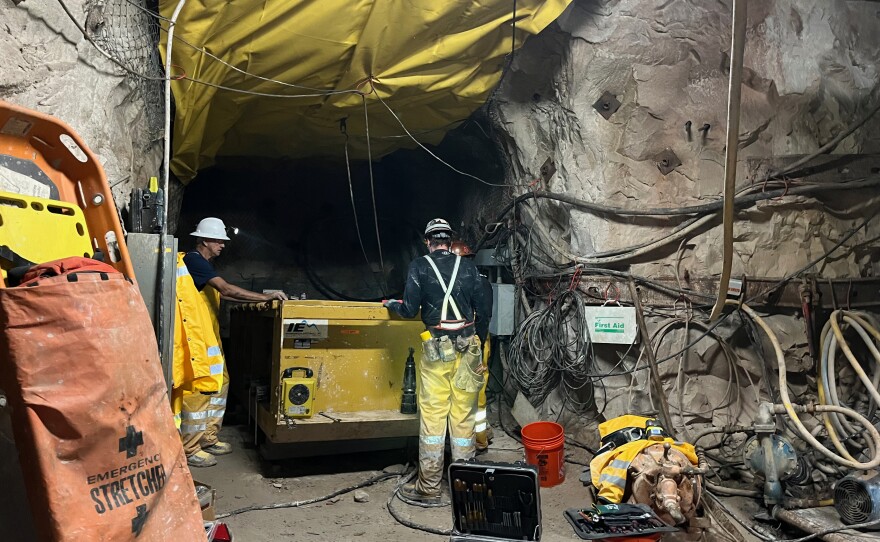In late July the first truckloads of uranium ore were shipped from the Pinyon Plain Mine near the South Rim of the Grand Canyon. The mine’s owner says they will be crucial for a future free of fossil fuels, but conservationists and Indigenous communities with cultural ties to the area have risen in protest.
Pinyon Plain is located on the Kaibab National Forest on a fenced-in 15-acre plot. The operations on the surface, which include modular offices and other buildings and the distinct headframe are somewhat unassuming. But the subterranean operations, in progress for decades, are an extensive maze of passageways blasted and dug out to allow the miners access to the uranium ore.
The bottom of the more than 1,400-foot mine shaft is reached by taking a 5-minute ride in a cage-like elevator called a “skip.” It is about as deep as the Empire State Building is tall and is a dark, wet and somewhat disorienting place, almost totally cut off from the rest of the world.
“There’s a peace down here where the phones don’t ring, the emails don’t chime,” says Matt Germansen, assistant superintendent of the Pinyon Plain Mine. “It’s just you and the miners you’re working with accomplishing a goal.”
That goal is digging out a geological formation called a breccia pipe he says contains some of the highest-grade uranium ore in the U.S. It is essentially a 3,000-foot rock chimney and the breccia pipes near the Grand Canyon, of which there could be thousands, are the only ones in the world known to contain uranium deposits.
Today, this vast network of tunnels resembles any bustling worksite. Germansen talks with electricians as the intermittent glow of nearby welding flashes from around the corner. A loader even navigates the tunnels as the whir of the mine’s ventilation system extracts stale air from the shaft.
“We make holes in the ground,” says Germansen with a laugh.
This hole in particular, however, has the unique distinction of being the only active uranium mine within the Baaj Nwaavjo I’tah Kukveni – Ancestral Footprints of the Grand Canyon National Monument. President Joe Biden designated it in August 2023, in part, to prevent hundreds of other similar uranium mines from popping up. But Pinyon Plain was allowed to continue operating because of preexisting rights. Those in the uranium industry were disappointed with the declaration, and Energy Fuels Resources, the mine’s owner, in particular, sees a lot of mining potential within the nearly million acres that are now protected.
“To declare a national monument is certainly frustrating because it feels like it was done without the science backing it,” says Germansen.
He and Energy Fuels insist the mine is safe to operate and will not affect the Grand Canyon’s groundwater or environment. So far regulators and courts have agreed. In 2022 the 9th U.S. Circuit Court of Appeals reaffirmed Energy Fuels’ right to mine at the site after the judges had revived a lawsuit from environmental groups and the Havasupai Tribe. The company also says the mine is part of the global transition away from fossil fuels and is expected to produce 2.5 million pounds of processed uranium over about six years. That is enough uranium, according to Energy Fuels, to power the whole state of Arizona for a year.

“If we’re going to address climate change, nuclear has to be part of that,” says Curtis Moore, Energy Fuels’ senior vice president of marketing and corporate development. “There’s just no way to get there without nuclear. Uranium powers nuclear … It’s by far our largest source of carbon-free electricity in the United States and it operates 24-7, 365. It operates regardless of weather. There’s a big global push for more nuclear for these reasons.”
Instability in uranium markets and other geopolitical factors like Russia’s invasion of Ukraine have, in the last year, also increased demand for domestic uranium production in the U.S. And Pinyon Plain, which began producing ore in early 2024, is part of that. Moore says the mine is heavily regulated and that mining is far safer now than in the past. But environmentalists are emphatic that it simply doesn’t belong in such a sensitive area less than 10 miles from the South Rim.
“There are places in the world, the Grand Canyon region being one of them, where operations like uranium mining, which are inherently dangerous, just have no business occurring,” says Amber Reimondo, energy director for the Grand Canyon Trust.
She and other conservationists worry that mining operations could pollute the seeps and springs of the canyon and even affect the larger Redwall-Muav Aquifer below.
“Water systems beneath the mine are not clearly understood,” says Reimondo.
The U.S. Geological Survey has studied the area for more than a decade after the U.S. Interior Department under the Obama administration imposed a 20-year moratorium on new uranium mining claims to allow for research into its possible effects.
“Our studies involve sampling, massive amounts of sampling—since 2012 we’ve collected almost a thousand water samples in the region to assess water chemistry,” says USGS research hydrologist Fred Tillman. “We look at uranium, we look at cadmium and nickel and arsenic and whole suite of elements that are in the water.”

Tillman and other hydrologists say there is no definitive evidence of water contamination from Pinyon Plain or other uranium mines near the Grand Canyon. But they caution that they do not yet have a complete picture of the canyon’s complex geology.
“Because of these unknowns, because of uncertainties about the direction and rate of groundwater movement in the area, if there were contamination that happened at a mine, we’re not sure when it would show up or exactly where,” Tillman says.
Indigenous communities have opposed uranium mining in the area for decades and it’s an unacceptable threat.

“This aquifer feeds into our village,” says Dianna Sue White Dove Uqualla, a Havasupai council member and a traditional practitioner. “This is the Havasupai Creek. It comes right up at the beginning of our village out of the ground. It’s an amazing thing to see but it’s pure, it’s pure, beautiful water.”
Uqualla also says the mine puts Havasupai spirituality at risk. Her people have traditionally conducted ceremonies at Red Butte, a short distance from Pinyon Plain. For the tribe, it is their place of emergence. But Uqualla says the radiation and uranium-laden dust prevent that.
“For us it is heartbreaking. We cry because we know we’re on the frontlines of this sickness or this contamination,” she says as she holds back tears.
The Navajo Nation is also protesting the mine. President Buu Nygren has vowed to stop trucks of uranium ore that recently began crossing the reservation.
“Our people are still dying today. They’re suffering. There’s so much generational trauma that uranium has brought to our people,” said Nygren as he addressed residents, tribal members and activists in the reservation town of Cameron during a protest in early August.
It came after Energy Fuels sent trucks hauling uranium ore from the Pinyon Plain Mine across parts of northern Arizona and the Navajo Nation on the way to southern Utah’s White Mesa Mill—the only operating uranium mill in the U.S. Nygren and other officials blocked traffic as they led the Cameron protest march on the northbound lanes of Highway 89, which days earlier had been part of the transport route. That same week Arizona Governor Katie Hobbs brokered a pause in the shipments to allow for talks between Energy Fuels and the tribe, which are currently ongoing.

The trauma Nygren described in his speech resulted from the more than 500 abandoned uranium mines on and near the Navajo Nation left over from the Cold War, which have been blamed for deaths, cancer and other grave health problems.
“I think it’s important to show solidarity in opposition to uranium transportation across the Navajo Nation,” says Navajo First Lady and former Arizona legislator Jasmine Blackwater-Nygren. She organized the Cameron protest, which was one of multiple demonstrations that also happened in Flagstaff and Grand Canyon Junction after the hauling began.
Blackwater-Nygren says two of her grandparents have died from radiation exposure, including a grandfather who was a former uranium miner. It’s an all-too-common story on Navajo.
“I think it’s touched almost every Navajo family, the legacy of uranium mining,” she says. “It’s very traumatic for me, for my family and I just think that as a Navajo people as a whole, we feel that hurt. It’s not just as individuals, it’s collectively we feel this.”
Energy Fuels is adamant that the ore has low levels of radiation and is safe to haul. But that hasn’t stopped the groundswell of opposition to the mine.
“When it comes to uranium specifically, I think there’s almost a moral obligation to say no and to make that message strong,” says Blackwater-Nygren.













